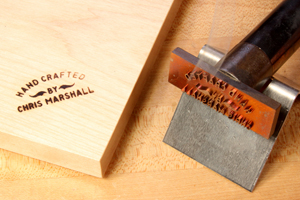
If you’re like us, you only watch the Antiques Roadshow to scope out the great furniture, not to see all of that other junk. If you’re a fan, you’ve probably noticed that a lot of the non-wood stuff is signed or has maker’s marks or something to identify who made it. But with the furniture, often as not, the pieces aren’t signed and the appraisers need to identify them by other details.
Paul Burri is out to change that. He makes metal brands so woodworkers can easily and permanently sign their work. His are made of copper and can be heated with a flame or an electric element and then burned into a surface of the finished piece.
It all started innocently enough. Paul, now the CEO and founder of BrandNew, was doing some woodworking about 30 years ago and decided he wanted to sign his work. So he silver-soldered some iron he had molded into the shape of his signature onto a plate and used that. He still uses that brand. It was years later that he wondered if others wanted to sign their work too.
Now Paul makes these branding irons for everyone and every use. Not just limited to woodworking, he says some of his branding irons are used to identify computer equipment at universities, to identify the bakery that made the fancy loaves of bread, and to identify the restaurant that made the steak that just landed on your plate. The brands are so versatile that they work on almost any surface.
Now Norm has a brand for his projects. So does Tom Lie-Nielsen. Paul talked with Sam Maloof about one, but Sam likes to sign his pieces carving freehand with a Dremel. To his credit, says Paul, Sam always signs his own name to a project and then insists that the apprentice or apprentices that helped him build it sign their names too. How would you like you have your name next to Sam’s on a woodworking project?
As Paul sees it, there are about six ways to sign a project: carve your signature with hand tools, carve it in with a rotary tool, use a pen , attach a metal label, use a paper label, rubber stamp your signature on it or brand it. The carving is nice, but time consuming. Metal labels are good, but you will probably need help making them. Paper labels are too temporary, as are rubber stamps and pen marks-especially if your piece is designed to last a few generations.
Paul’s company can sell you one of its established designs or, better yet, you can send in your own design for a brand. We can imagine more than a few Shopsmith owners who would want a picture of their beloved Mark V as part of their brand.
So that’s why Paul advocates branding irons. The only drawback, he says, is when you’re trying to brand curved surfaces. That takes a bit of coordination as you roll the plate across the surface. And spherical surfaces are nigh impossible, says Paul.
So how much of a craftsperson do you need to be before you get yourself a brand? Paul says you should start signing your work right away. If, he says, the finished piece isn’t good enough to sign, it should probably be on the firewood pile.
And who knows? A century or two from now, some appraiser may turn over one of your coffee tables and say, “Clearly from the craftsmanship and the signature, this is a classic early work of [your name here]. This is worth a fortune.”
– Bob Filipczak






